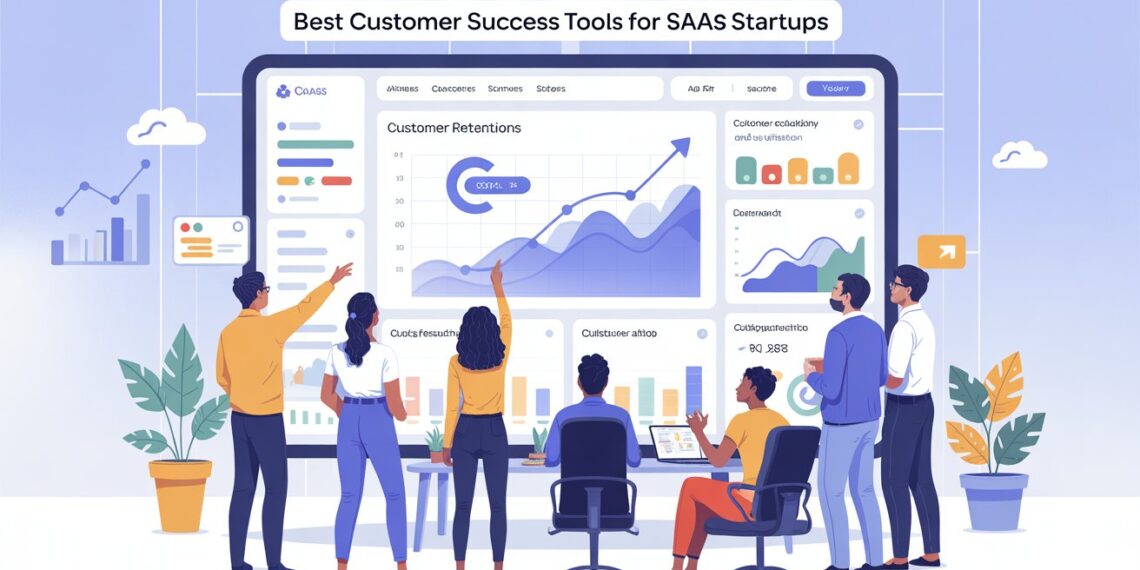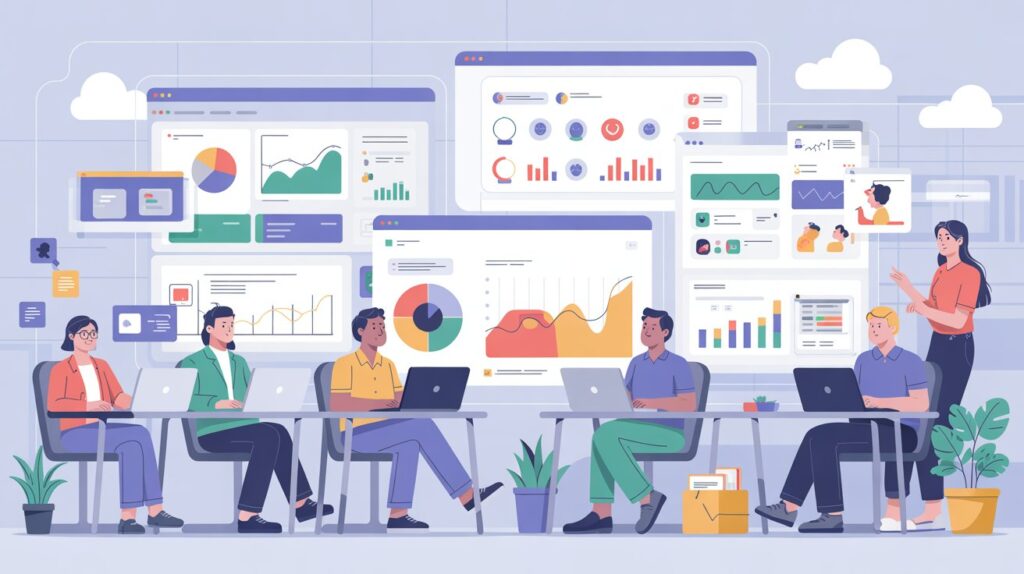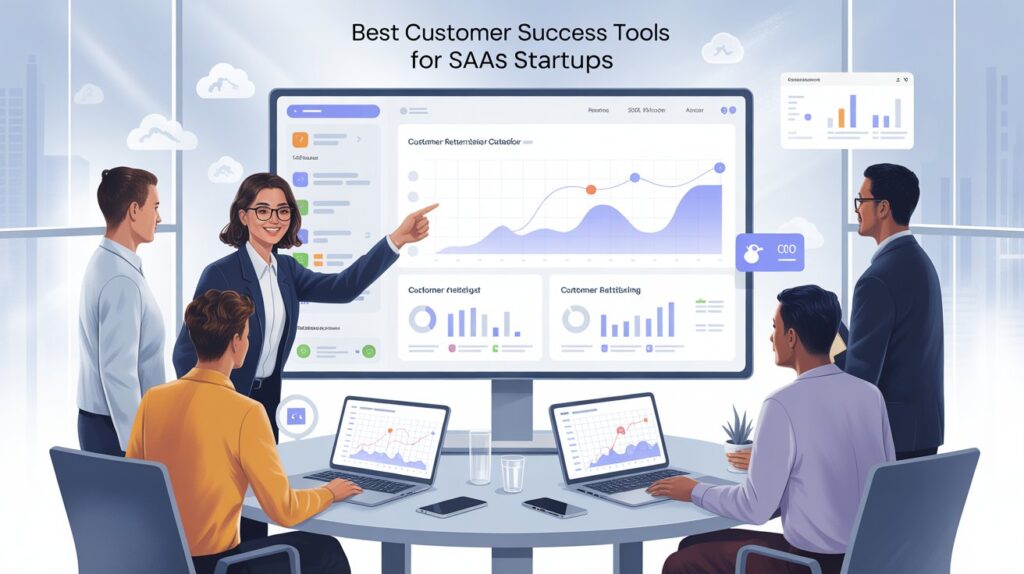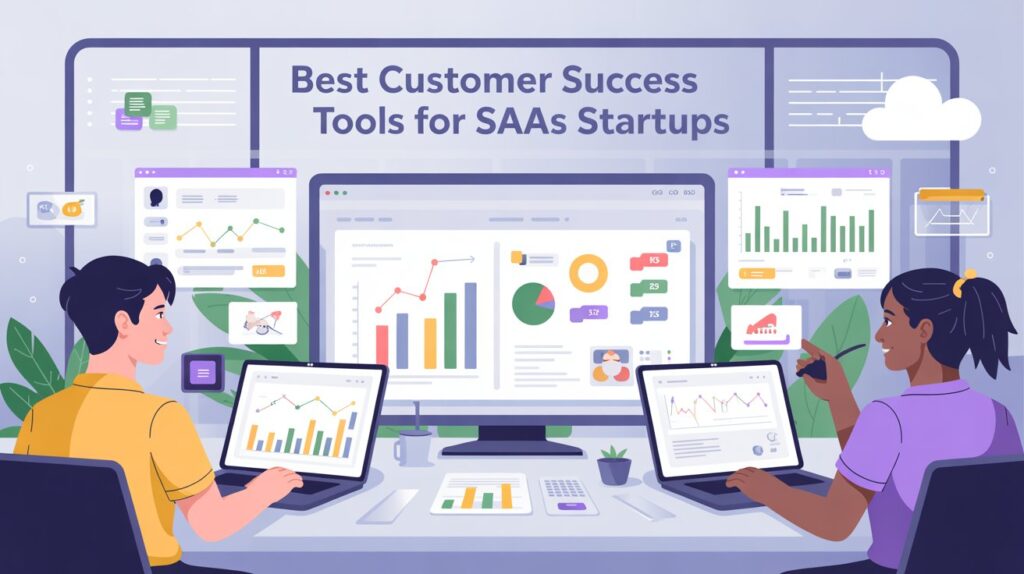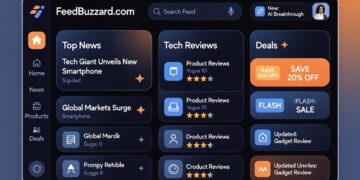In the hypercompetitive world of SaaS, acquiring customers often takes center stage. But sustaining growth—and profitability—depends even more on retaining existing customers and helping them succeed. That’s where the right tooling comes in. For SaaS startups especially, having effective customer success tools early can make or break your retention metrics, expansion rates, and overall growth trajectory.
In this article, you’ll get a deep dive into Best Customer Success Tools for SaaS Startups, how to evaluate them, practical implementation tips, pitfalls to avoid, and a forward-looking view. My goal: help you choose tools not just because they look good—but because they match your stage, team, budget, and ambitions.
Why Customer Success Tools Matter for SaaS Startups
Before jumping into tool names, it’s critical to understand why these platforms should be part of your core toolkit. Particularly for startups, where every resource is precious:
-
Churn is fatal early on. Losing customers in early stages can drastically slow growth. Proactively identifying risk helps you intervene before it’s too late.
-
Efficiency and scalability. You can’t scale a manual, ad hoc process. Tools let you automate repetitive check-ins, alerts, and workflows.
-
Data-driven decisions. These tools consolidate usage, support, billing, and behavioral data so you understand what drives retention, expansion, and churn.
-
Focus your human resources. Allow your small team to focus on high-value tasks (coaching, relationship building) while automation handles low-value touchpoints.
-
Alignment & visibility across teams. When success, product, sales, and support are aligned around the same data, cross-functional decisions improve.
Given those benefits, your choice of tool should reflect your startup’s maturity, constraints, and growth path.
What to Look for: Criteria for Startup-Friendly Customer Success Tools
To pick a tool that truly fits a SaaS startup (vs. large enterprises), here’s a checklist of essential attributes:
-
Ease of Onboarding & Setup
You don’t want to waste engineering cycles. Look for tools with prebuilt connectors, managed onboarding, or “plug-and-play” integrations. -
Modular / scalable pricing
You may not need a full platform from day one. Tools that offer starter tiers or modular add-ons help you grow without overspending. -
Good integrations with your stack
Must connect cleanly with your CRM, billing / subscription data, product analytics (e.g. Segment, Amplitude, or Mixpanel), support / helpdesk, and possibly marketing tools. -
Robust health scoring + alerts
Combining multiple signals (usage, support tickets, sentiment, feature adoption) to surface accounts at risk. -
Automated playbooks & workflows
Trigger tasks, emails, or in-product nudges based on defined rules or inferred signals. -
Segmentation & custom dashboards
Ability to slice customers by segments (e.g. plan, usage, region) and build tailored dashboards. -
Feedback / survey / NPS / CSAT modules
Built-in tools to measure sentiment and feed that into your success logic. -
Task & alerts / action management
For those accounts your automation can’t fully handle, you need clear tasks & reminders. -
Scalability & flexibility
The tool should not become a bottleneck when you grow. Flexibility in metrics, custom fields, API access, and extensibility matter. -
Support, community, documentation
Early stage teams often need help. Tools with good support and community will save you hours. -
Security, compliance, data privacy
Even early, you must ensure your tool handles data thoughtfully (e.g. GDPR, role-based access, data encryption).
If a tool meets most of those criteria, it’s likely a strong candidate for a startup environment.
Top Tools for SaaS Startups in 2025
Here is a curated list of customer success platforms and tools that currently stand out for SaaS startups. Each tool is strong in certain niches; use the criteria above to pick the right fit.
Tool |
Best for / Startup Fit |
Strengths |
Trade-offs / When to Wait |
|---|---|---|---|
Totango |
Startups wanting modular growth |
SuccessBLOC modules allow you to enable only what you need; decent onboarding and community support intercom.com |
As you scale, you may outgrow constraints in deeper customization |
Custify |
Lean startups / mid-tier growth |
Built for SaaS, strong usage analytics, health scoring, good integrations custify.com+1 |
Not as enterprise-feature heavy as top-tier platforms |
ChurnZero |
SaaS teams focused on churn prediciton |
Real-time visibility, usage tracking, automated touchpoints crescendo.ai |
Pricing may become steep as your account count grows |
ClientSuccess |
Startups needing simplicity |
Marketed as easy to use, fast to implement clientsuccess.com |
Less advanced analytics and features compared to bigger platforms |
Gainsight |
For ambitious startups heading toward enterprise |
Deep analytics, mature feature set, widely trusted RevPilots+1 |
High cost, steep learning curve |
Planhat |
UI + reporting enthusiasts |
Clean UI, strong analytics, flexible models RevPilots |
May require some custom work to fit unique startup workflows |
Vitally |
Product-led growth / adoption focus |
Strong in in-product nudges, usage insights, automation (not always in every list but recognized among CS tools) |
Still building in some peripheral features |
SmartKarrot |
B2B SaaS with midmarket ambitions |
AI assistance, integrated journeys, solid feature set intercom.com |
A bit heavier; might require more setup |
Akita |
Lightweight, usage-focused teams |
Simple, clear product metrics + playbooks intercom.com |
Less mature in full CS lifecycle support |
Sources: Intercom’s “Best Customer Success Tools” list includes Totango, SmartKarrot, Akita, Custify, etc. intercom.com
Also, Crescendo’s list highlights ChurnZero, Custify, Totango as relevant for SaaS teams. crescendo.ai
Zapier also suggests tool fits by company size (e.g. ClientSuccess for startups) Zapier
The Zendesk guide lists 18 CSM tools and gives good view of market breadth. Zendesk
Highlighted Tools (Deep Dive)
Let’s look in more detail at a few tools that make especially compelling cases for SaaS startups:
Totango
-
Modular “SuccessBLOCs” let you deploy onboarding, retention, advocacy components bit by bit. intercom.com+1
-
Prebuilt templates reduce time to value.
-
Strong community and resources.
-
Possible drawback: as your workflows become more complex, some modules might require custom work.
Custify
-
Purpose-built for SaaS, the platform puts usage data, health scoring, and automation front and center. custify.com
-
Integrates with popular tools (CRM, billing, product analytics).
-
Good for lean teams that want robustness without overbearing complexity.
ChurnZero
-
Excels in predictive analytics: it flags users at risk based on usage, behavior, or custom triggers. crescendo.ai
-
Automations for onboarding, renewal prompts, in-app messaging.
-
Potential cost and complexity ramp as customer base scales.
ClientSuccess
-
Simple, intuitive interface, quick to get started. clientsuccess.com
-
Good for early-stage teams not needing heavy analytics or predictive modeling.
-
Less suited when you need deep segmentation, advanced custom metrics, or predictive models.
Gainsight
-
Often seen as the enterprise benchmark. Deep capabilities across metrics, playbooks, forecasting, integration, etc. RevPilots+2birdviewpsa.com+2
-
For startups with aggressive scaling plans, Gainsight may be justified.
-
Downsides: steep learning curve, cost, and overkill features for smaller teams.
How to Select the Right Tool for Your Startup
Selecting among these tools can feel overwhelming. Here is a decision framework to guide you.
Step 1: Map Your Stage & Priorities
Ask:
-
How many accounts do we have now?
-
What is our current churn issue (usage dropoff, support issues, onboarding failures)?
-
What is our budget for CS tooling?
-
How much engineering time are we willing to commit?
-
What existing tools do we already rely on (CRM, analytics, support)?
From that, classify your environment:
-
Early / seed-stage (0–100 customers): You need minimal overhead, simple metrics, rapid setup.
-
Growth-stage (100–1,000 customers): You need automation, segmentation, predictive detection.
-
Expansion / pre-IPO stage: You need deep analytics, forecasting, cross-team alignment.
Step 2: Score Tools Against Your Weightings
Create a weighted scorecard. Example:
Feature / Criterion |
Weight (1–10) |
Tool A |
Tool B |
Tool C |
|---|---|---|---|---|
Ease of setup |
8 |
7 |
9 |
8 |
Integration with analytics |
7 |
6 |
8 |
7 |
Flexibility & customization |
6 |
5 |
7 |
6 |
Automated playbooks |
8 |
8 |
7 |
9 |
Pricing scalability |
9 |
6 |
9 |
8 |
Support & documentation |
5 |
7 |
8 |
6 |
Score each tool and pick the top quadrant. Reassess yearly as you grow.
Step 3: Try Before You Buy
-
Use free trials or pilot plans with real data.
-
Simulate actual workflows: onboarding, health alerts, expansions.
-
Evaluate how easy it is for your team to adopt.
-
Measure time to value: how long till you see insights or alert positivity.
Step 4: Plan for Migration Flexibility
Even the best tool may not remain ideal forever. Ensure:
-
You can export your data cleanly (customer metrics, scores, history).
-
API access exists so you can build custom connectors later.
-
You don’t lock yourself into proprietary logic you can’t replicate.
Implementation Guide: How SaaS Startups Should Roll Out CSM Tools
A great tool does little without good adoption. Here’s a phased implementation playbook for startups.
Phase 1: Groundwork & Data Cleansing
-
Audit data across CRM, billing, usage, support.
-
Define “customer health” signals: usage thresholds, support tickets, logins, etc.
-
Prioritize 2–3 core signals initially rather than 20.
-
Clean and normalize fields (naming, timestamps, unique IDs).
Phase 2: Simple Automations & Alerts
-
Set up basic health scoring and alerts (e.g. “customer not logged in for 7 days”).
-
Trigger internal tasks to reach out to flagged accounts.
-
Use simple playbooks (e.g. onboarding email series).
Phase 3: Segmentation & Nurture Tracks
-
Divide customers by type (free vs paid, plan, region).
-
Tailor playbooks / campaigns per segment.
-
Track engagement, adoption of key features.
Phase 4: Predictive & Expansion Signals
-
Use churn prediction models or machine-learning features in tools.
-
Add upsell / expansion signals: behavior patterns, power features, usage surges.
-
Trigger renewals / upsell playbooks automatically.
Phase 5: Feedback Loop & Iteration
-
Regularly review false positives / false negatives.
-
Tweak thresholds, rules, weights.
-
Monitor key metrics (churn rate, net retention, expansion rate).
-
Align with product & marketing: feed signals back to roadmap decisions.
Phase 6: Continuous Optimization
-
As usage and customer count grow, you can expand rules, predictive layers, and automation complexity.
-
Plan for tool migration only if there’s a clear reason (cost, missing features, scaling limits).
Common Mistakes & Pitfalls
-
Choosing the biggest brand rather than what fits your stage
-
Overloading early: building dozens of automations before validating core workflows
-
Ignoring data hygiene; dirty data ruins health scoring
-
Not involving stakeholders (product, sales, support) in adoption
-
Locking into a tool without considering export / migration
-
Underestimating hidden costs (API calls, data volume, support, training)
-
Letting tool usage devolve into “set and forget” instead of active iteration
FAQs
Q: When should a SaaS startup start using a dedicated customer success tool?
As soon as you begin seeing churn or manual processes become a drag. Even with 20–50 customers, a lightweight tool (or partial usage of your CRM + basic automation) can help. The right decision is about whether the tool will relieve enough friction to justify its cost and adoption effort.
Q: Can I start with spreadsheets and move to a tool later?
Yes, many startups begin with spreadsheets or simple dashboards. But you will reach a scaling pain point: manual tracking becomes error-prone, and you miss real-time signals. The trick is migrating early enough that you don’t ossify workflows around your sheets.
Q: What metrics should my tool help me monitor?
Core metrics include churn / retention, net dollar retention (NDR), expansion rate, customer health over time, usage of key features, support tickets per account, renewal rate, NPS/CSAT trends, time to value (TTV).
Q: Are there free or open-source customer success tools?
Some tools offer generous trial tiers or free tiers for small usage. Also, open-source or lower-cost tools may be viable early on, but often lack polish, support, or integrations. Use them as stopgaps, not long-term infrastructure.
Q: What if I outgrow my tool? How hard is migration?
That depends on how clean your data, how modular your logic, and how exportable your histories are. Before choosing, check that the tool allows bulk export of customer metrics, scores, histories, playbooks, and has APIs so you can reconstruct workflows elsewhere.
Trends & The Future of Customer Success in SaaS
Looking ahead, here are a few trends that SaaS startups should be aware of:
-
AI & predictive copilots. Using machine learning to forecast churn, suggest next best actions, automate outreach.
-
In-product success interventions. Rather than emails or tickets, guiding customers within the app (tooltips, prompts, embedded workflows).
-
Revenue-run CS teams. Customer success teams increasingly own expansion, upsell, and cross-sell revenue, not just retention.
-
Stronger integration between product analytics & CS. Seamless bridging of usage data with success logic.
-
More self-service, proactive insights. Customers expect you to detect issues before they do; tools must help you be anticipatory.
Startups that adopt these forward-thinking capabilities early can gain a competitive advantage in retention, engagement, and customer lifetime value.
Conclusion
Selecting the Best Customer Success Tools for SaaS Startups is not about picking the flashiest platform—it’s about choosing one that fits your stage, resources, and goals. Begin with clarity: define your metrics, your pain points, and your growth plan. Use a decision framework, pilot with your real data, and evolve your usage over time.
By following a phased rollout, focusing on data hygiene, and continuously iterating, your startup can use these tools as engines of retention, expansion, and customer delight. If you like, I can build a spreadsheet decision matrix customized to your startup’s specifics to help you pick between these candidate tools—would you like that?

